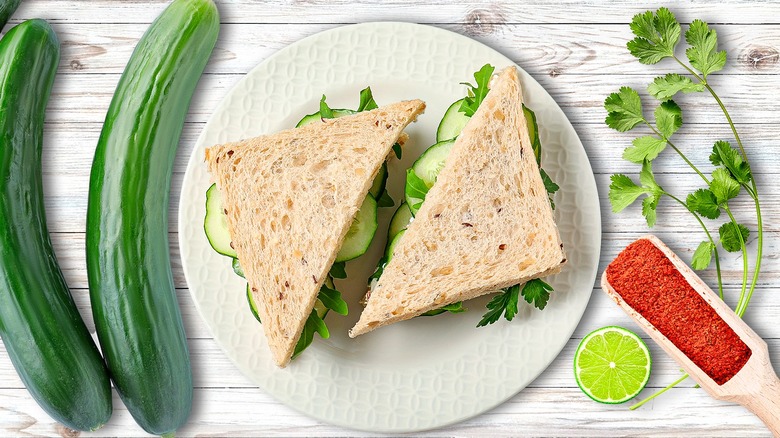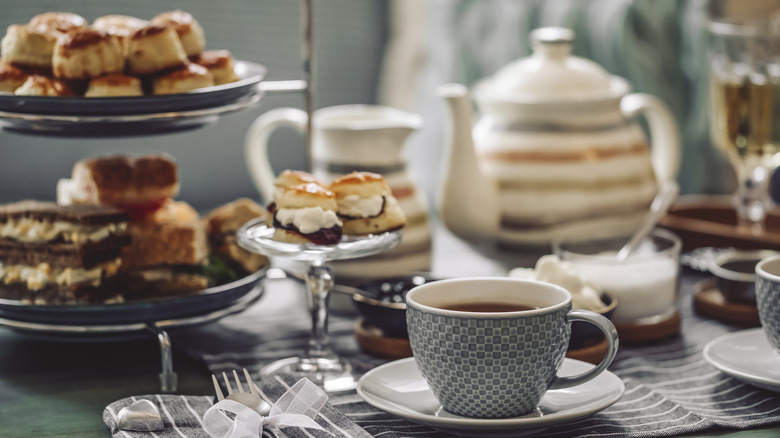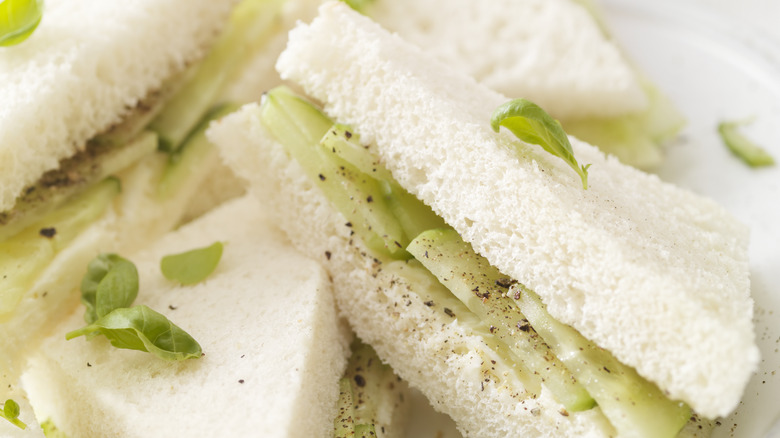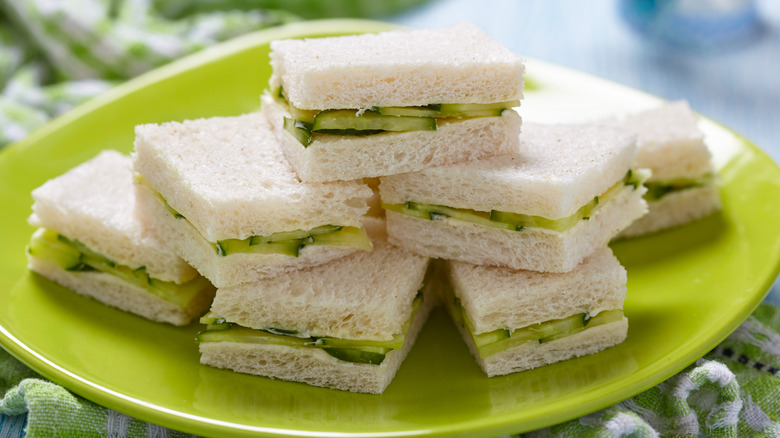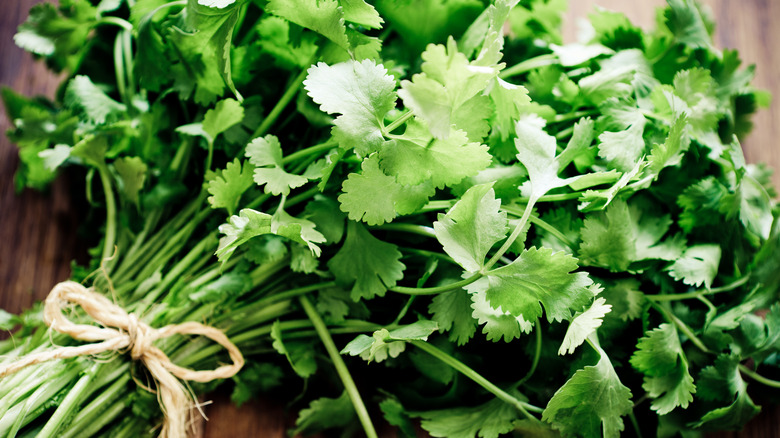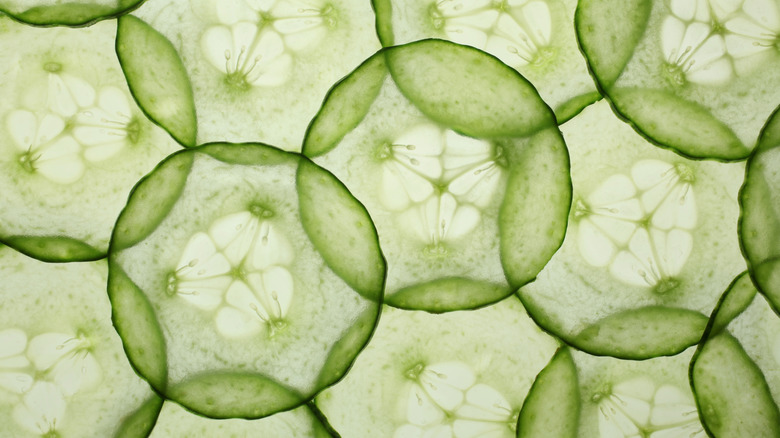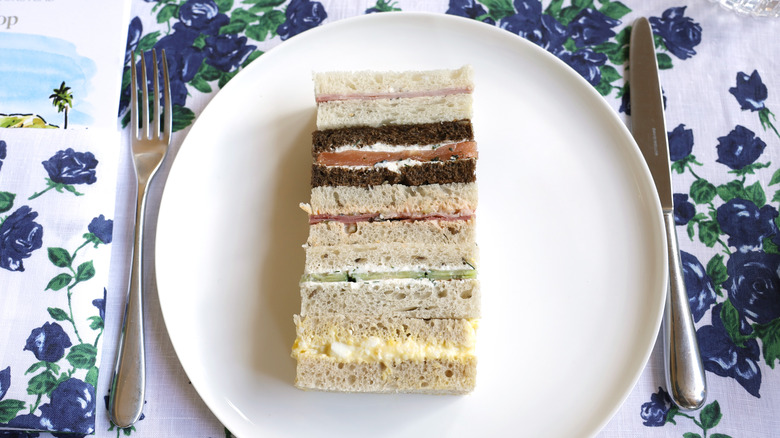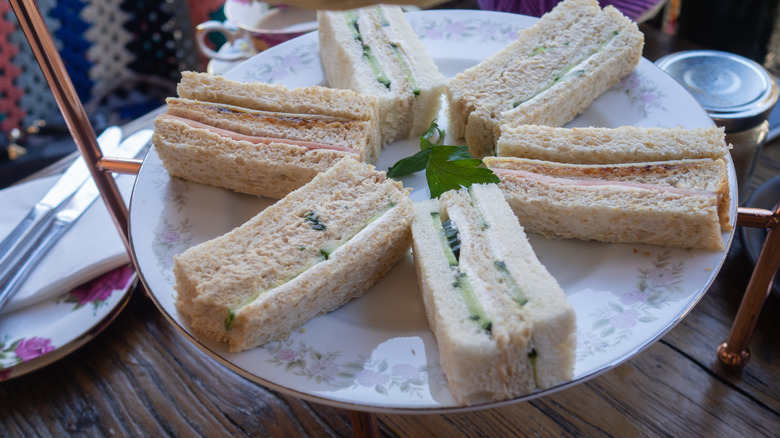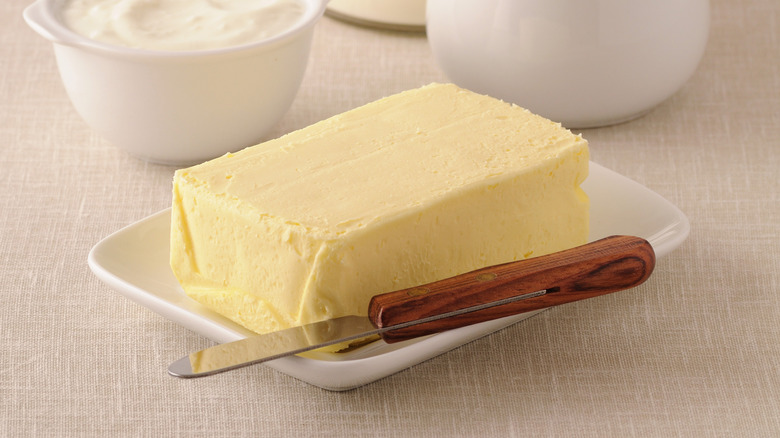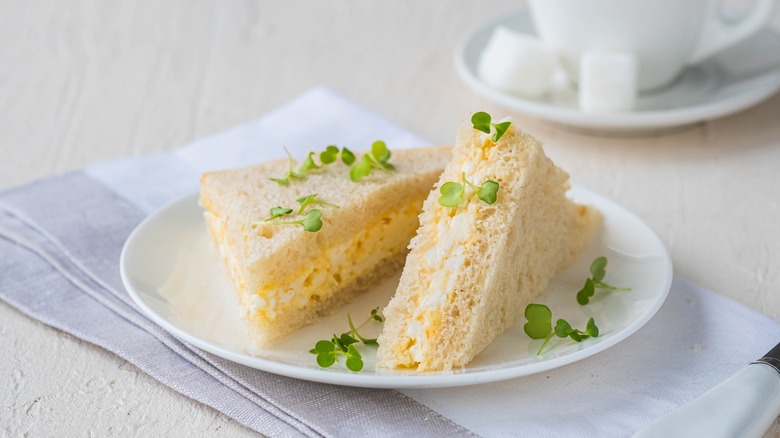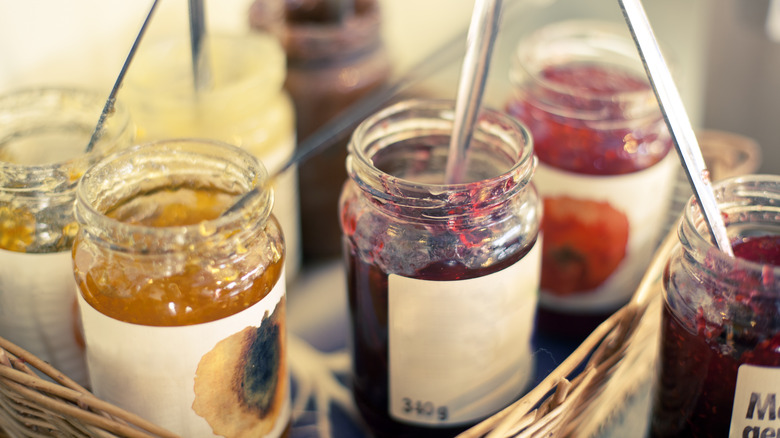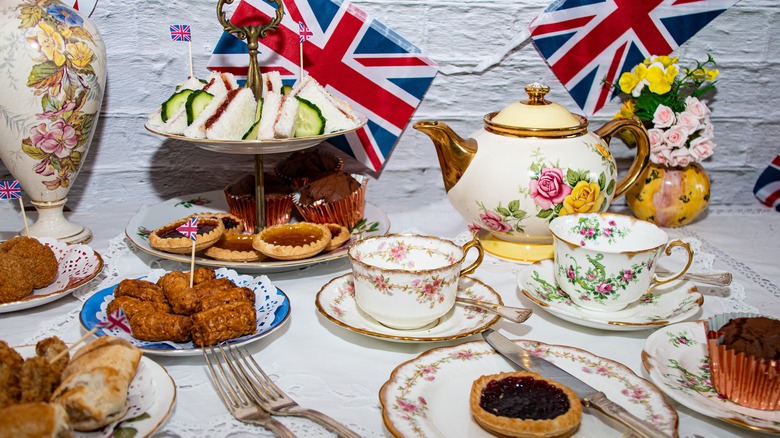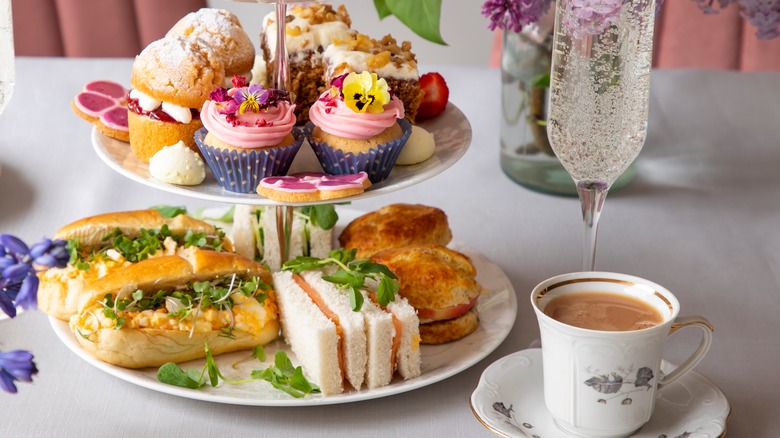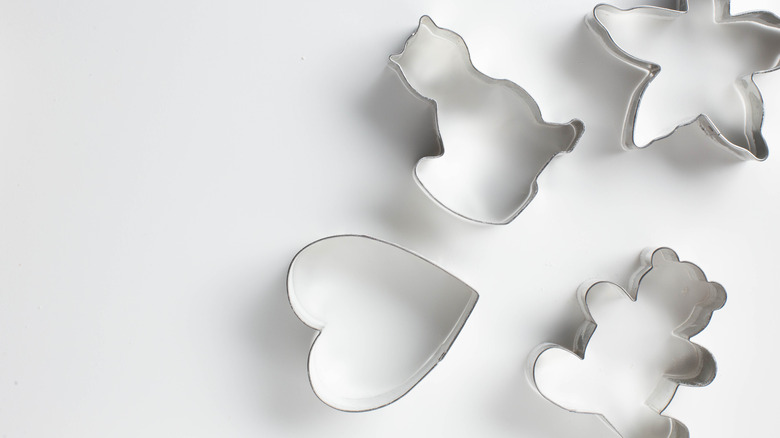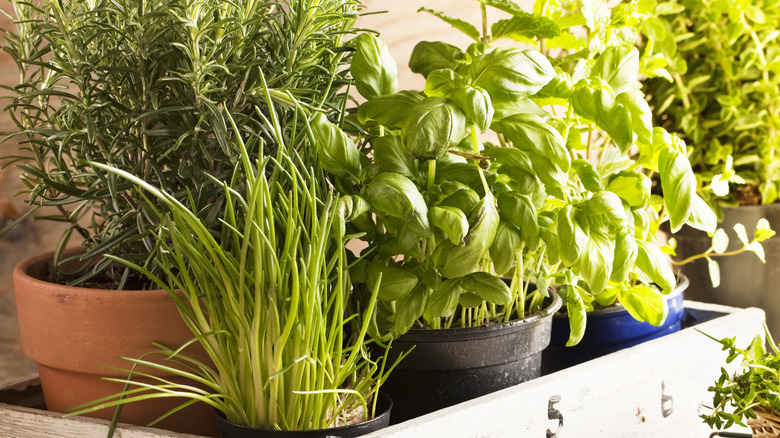14 Tips You Need When Making Tea Sandwiches
Afternoon tea is a hallowed tradition, historically in England and now the world over. And tea sandwiches — those dainty geometric creations of simple yet supremely balanced fillings held between meticulously shaped slices of bread — are the jewel in the crown. And we do mean afternoon tea, not high tea. Commonly and incorrectly used interchangeably, afternoon tea, aka low tea — we're not joking — began in the 1840s as an indulgent moment for socialites to lounge around between 3 and 4 p.m. gossiping over scones and, yes, tea sandwiches. High tea, on the other hand, was traditionally an all-out evening feast for hungry workers.
Perched at the top of a cake stand or piled high in gravity-defying formations, we'll take tea sandwiches however they come, except when we won't. That's right — while relatively straightforward to whip up at home and with some showstopping tried-and-true flavor combinations to fall back on if you're feeling creatively stretched, successful afternoon tea is won and lost on the caliber of your tea sandwiches. From hacks for tea sandwich construction and assembly to modern flourishes that'll be applauded amongst your fellow afternoon tea-takers and notes on perfect tea sandwich storage, we've rounded up everything you need to know so your tea sandwiches will be the talk of the town (or, at least, the table).
Pair tea sandwiches with teas
A cup of black tea might be the traditional pairing for tea sandwiches, but as anyone who's ever taken a chance on a more unexpected food and beverage pairing knows (how to pair wine with your Halloween candy, anyone?), stepping away from tradition can be deliciously rewarding. Tea sandwiches are no exception to this rule. In 2002, Michelin-starred chef Heston Blumenthal noticed unexpectedly successful food pairings just so happen to have common chemistry. He described this with The Food Pairing Theory, but it was later partially debunked when a study at Harvard University found the theory didn't hold for Southern European and East Asian dishes. Luckily, we don't need deep science to confirm that some textures just work well together.
Egg salad tea sandwiches and organic Earl Grey tea pair immaculately, whereas a chai's bold spice profile is a wonderful complement to the creaminess of chicken salad tea sandwiches. Jasmine green tea proves a whimsical, floral partner to cucumber tea sandwiches, and the warmth of ginger turmeric blends marry well with roasted turkey sandwiches. Salmon slams with a squeeze of lemon, so pair smoked salmon tea sandwiches with lemon black tea to capitalize on this classic pairing.
Tea sandwich geometry is sacred
The dainty, crustless silhouettes of tea sandwiches — from rectangular 'fingers' to circles and triangles — add to the charm of an afternoon tea. In fact, according to the Cambridge Dictionary, which defines these tea sandwiches as "a sandwich cut into a small rectangle, square or triangle, usually with the crusts cut off," if a supposed tea sandwich doesn't take a geometric form then it isn't technically a tea sandwich at all.
So we're in agreement that tea sandwiches must be perfectly formed, but is there a 'right' way to slice a tea sandwich? The answer, apparently, is a strong yes, at least as far as Kemp Minifie, the former executive food editor of the iconic Gourmet Magazine, is concerned. Cut your tea sandwiches (or any sandwich for that matter) into triangles and they'll be easier to eat simply sailing into your mouth. Perhaps that's what garnered them the nickname "sailboat sandwiches."
Master classic flavor combinations first
While we're all for culinary creativity, classic flavor combinations are classics for a reason, and before you go all Willy Wonka on your tea sandwiches, you best have nailed these tried-and-true fusions. Enter cucumber and butter or cucumber and cream cheese, perhaps the most quintessential tea sandwich combinations to ever grace our plate. Simple and texturally pleasing — with the freshness and crunch of the cucumber as an epicurean counterpoint to the softness of the bread — a tower of refreshing cucumber sandwiches has a place in any afternoon tea.
Other classics to include in your base repertoire are cheese and chutney (preferably using a sharp, aged cheddar), roast beef — a great way to use up leftovers — egg salad, smoked salmon and cream cheese, and Coronation chicken salad. For the uninitiated, the latter is a blend of poached chicken in onions, curry, tomato, red wine, lemon juice, mayonnaise, whipped cream, and apricot purée created in 1953 for Queen Elizabeth II's coronation.
Add cilantro, chili and lime for a spicy upgrade
Sometimes, the best hacks are the most minimalist ones. This spicy cucumber tea sandwiches recipe is a case in point. Gently elevating the iconic cucumber sandwich, it's both comfortingly familiar and pleasantly surprising, the cilantro, chili, and lime providing a punchy, zesty counterpoint to the smoothness of the cream cheese. Tasting Table recipe developer and pastry chef Katie Rosenhouse suggests pairing these elegant morsels with mimosa or fresh fruit, another unexpected addition to your afternoon tea lineup.
Yet another way to up the ante with minimal effort (and resources) is adding a drizzle of salad dressing to your tea sandwich. Give your tea sandwiches a herbaceous moment with this green goddess dressing, or boost the indulgence factor by adding raspberry vinaigrette to a chicken, brie, and cranberry combination. Of course, a mustard-based dressing would marry well with a ham filling, and go with creamy or citrus for a seafood filling.
Salt your cucumber slices
There most certainly are things worse than soggy tea sandwiches, but when you're mid-afternoon tea, it won't seem like it. While we wouldn't usually recommend rubbing salt in the wound, in this particular scenario, it's the only way forward.
So, how does one keep cucumber slices crisp for delicate sandwiches? Cucumber tea sandwiches are almost foolproof. Almost. If the cucumber slices are too wet, people will be talking about your afternoon tea for all the wrong reasons. To avoid this crucial faux pas, slice your cucumber and place it on a paper towel, sprinkling generously with salt. By nature of osmosis, a process where fluid moves from an area of high to low concentration, over the next 20 minutes, the salt will pull some of the moisture out of the cucumber before it has the chance to wreak havoc between your slices of bread. As a bonus, you won't have to salt the rest of your sandwich — the cucumber slices will provide all the saltiness you need.
Dare to stray from white bread
White bread is the go-to carb for tea sandwiches; for some, it'd be a crime to use anything but. After all, its mild taste makes it a flawless vehicle for giving the carefully curated filling a well-deserved spotlight. However, going one step further and choosing bread that complements rather than just carries the filling might just be a welcome upgrade.
Dark rye bread, or German pumpernickel, is the bread to give cucumber tea sandwiches a flavor boost. Heartier and more robust than white bread, it brings more structural integrity, savory notes, and an additional crunch (if seeded) to the humble cucumber tea sandwich. Egg salad is great sandwiched between two slices of seeded wheat, the crunch cutting through the softness of the salad. And if your fillings are on the sweeter side, match your bread accordingly — a layer of peanut butter and jelly is sensational between two generous slabs of brioche.
Cut the crusts off
The idea that eating bread crusts would give you curly hair has long been debunked, although we're skeptical whether anyone ever believed it in the first place — it's much more likely it was used as a threat to compel curly hair-loving fussy eaters to just get on with it. Crusts are, however, more nutritious than the middle part of the bread, but if we're staying true to the traditional aesthetic of tea sandwiches, those crusts have got to go.
But what do you do with empty crusts? In 2019, the BBC reported that 1.2 billion bread crusts are wasted every year in the UK. Food waste is the pits, so instead of binning your crusts, transform them instead, blitzing them in a blender for homemade breadcrumbs. From there, the possibilities are endless: You could use them as a binder in meatballs or burger patties, crust vegetables for a crunchy vessel for dip, or you could even jazz up store-bought ice cream with a sprinkle of bread crumbs.
Butter your bread
Butter repels water, making it a useful tool for safeguarding the structural integrity and freshness of your bread. Just as you spread butter on bread to prevent soggy freezer sandwiches, a thin layer of butter (or any spread with a high-fat content like mayonnaise) creates a barrier that's great at preventing filling bleed, aka the textural nightmare where your two sad pieces of wet bread slowly implode leaving you covered in a mush of indiscriminate filling. Just be sure to spread the butter to the edges so no moisture can seep through and ruin all your hard work.
Now, if you've ever attempted to butter a slice of bread only to have it rip in two, prepare to have your mind blown — work with your bread as a whole block rather than individual slices. Start by cutting the crusts off your entire loaf so you're left with one crustless block. Next, butter one end, then use a sharp knife to slice. Butter the new end, slice, and continue until the entire loaf has been sliced. Similarly, if you're making finger sandwiches, slice your de-crusted loaf into three long blocks before buttering and slicing end to end.
Construct your tea sandwiches intentionally
Biting into a sandwich and having all the filling escape out the back simply isn't a vibe. Luckily, there's a trick for dealing with slippery sandwich ingredients: friction. The various elements of your sandwich filling can be assembled to create friction between the wetter and dryer ingredients, thus holding everything in place and ensuring you can have your sandwich and eat (all of it), too.
The core tenant of a well-constructed sandwich is alternating wetter ingredients, like tomato and cucumber, with drier components, like cheese or shredded lettuce (spun dry post-washing, of course). For a cheddar and chutney tea sandwich — after sealing each slice of bread with a thin layer of cream cheese — you'd place a slice of cheddar directly onto the bread and pile the wet chutney on top before topping with another slice of cheddar and the final piece of bread.
Sweet tea sandwiches go down a treat
Traditionally, tea sandwiches were served at the beginning of high tea as a consumption control tool. Revelers would tuck into the tea sandwiches, filling up just enough to still allow room for some of the sweets (fruit tartlets, Battenberg cake, shortbread, and the like) that followed while preventing gorging and spoiling their appetite for dinner. You'd think, therefore, sweet sandwiches would have no place in an afternoon tea, but you'd be wrong.
Enter jam pennies, a circular sandwich with a strawberry jam filling and a thin layer of butter that was one of Queen Elizabeth II's favorite foods. If the queen can break with tradition and have her sweet and savory in one delicious hit, we can, too. We can draw inspiration from our own backyard as well, with a miniature fluffernutter sure to be the talk of your next afternoon tea, or, further abroad, a Japanese-inspired fruit sando where soft cream and sliced fruit are housed in sweetened white bread.
Don't go overboard on the fillings
Look, we get it. Sometimes, you want to reincarnate an Everything Bagel on your tea sandwich, but we're here to implore you to resist that temptation or, at most, season your tea sandwich with some DIY Everything Bagel seasoning and be done with it.
Part of the universally loved qualities of tea sandwiches is the ease with which they're eaten and with just one hand at that. If you've ever tried to wrap your mouth around a towering burger, you'll know that more fillings immediately complicate the situation. What's more, a tea sandwich is a celebration of simplicity, allowing a modest pairing of flavors to have the spotlight. Eileen Donaghey, aka The Afternoon Tea Expert's rule of thirds, is one of the best tips you need when making tea sandwiches: one-third bread, one-third filling, one-third bread. Essentially, you're aiming to fill the sandwich only as thickly as the slice of bread itself.
Serve tea sandwiches immediately
In an ideal world, you'd whip up a batch of tea sandwiches just before your guests sit down to eat so they're as fresh as possible. We all know that isn't always realistic, so if you are prepping your sandwiches in advance, they'll do fine in the refrigerator in the interim with two caveats: you're going to need an airtight container and a paper towel.
Wrapping your sandwiches in a paper towel before sealing them away in a container is the clever trick that will keep your sandwich from turning soggy. The paper towel wicks excess moisture away from the bread so that when it comes time to serve, hey presto (or should we say, hey pesto?), your sandwiches will be just as fine as when you made them. And if your tea sandwiches need to travel to their end destination, choose parchment, wax paper, or beeswax wrappers over plastic wrap or aluminum foil. Wrap each sandwich individually and firmly to hold everything in place without squashing them, and they'll arrive ready to eat.
Use a cookie cutter
Using a cookie cutter is a simple way to cut satisfying circle bread for tea sandwiches. Don't have a cookie cutter on hand? Flip a glass upside down and trace around the rim with a sharp knife. This is a great hack for if you're using white or another soft bread, but if you're working with something more robust, it's worth investing in a set of cookie cutters, which you can find from your local kitchen store or thrift shop.
Your tea sandwiches could be the star of the show if you build a themed afternoon tea inspired by whatever cookie cutters you're able to get your hands on. From star-shaped tea sandwiches with 'asteroid' cake pops for a galaxy theme to a Valentine's Day spread where each heart-shaped tea sandwich is pierced with a capsicum 'arrow' or even just different-sized circles as a culinary salute to dot-loving Japanese contemporary artist, Yayoi Kusama, or Andy Warhol's ben-day dots; the possibilities are endless.
Season the edges of your sandwich
If you do choose to trim the edges off your tea sandwiches (and even if you don't), you should definitely season the edges. The resulting herb crust is such a legitimate way to take your tea sandwich game to the next level.
Delightfully, leveling up your afternoon tea in this way is easy. Firstly, chop up a bunch of fresh herbs, and then prepare your tea sandwich as you normally would. Next, brush the edges with mayonnaise, butter, or light mustard for a spicier accent, then dip into chopped herbs for a pop of green. Any seasonal herbs will work well, but you can further curate the experience by choosing herbs that naturally complement the fillings, like chives for a filling of salmon and cream cheese or finely chopped Italian parsley for a filling that's Mediterranean-inspired.
